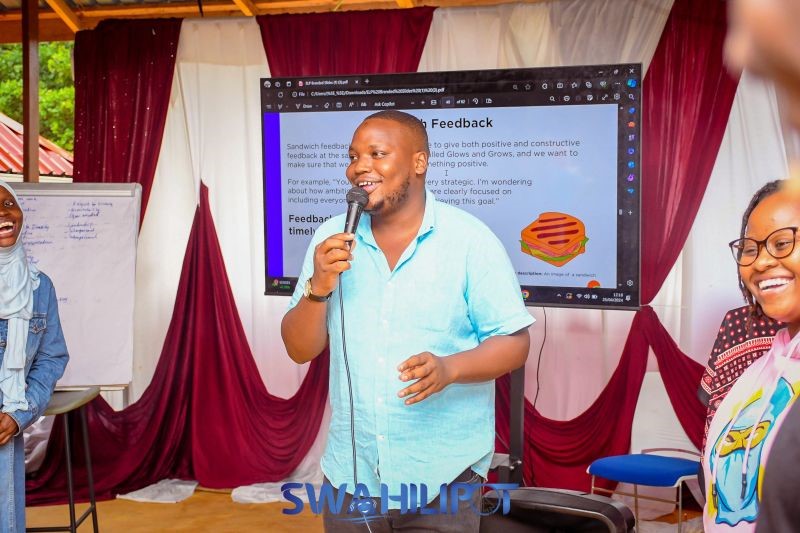By Rajab Salim
TOT (Trainer Of Trainers) / Equity Leadership Program (ELP)
Community participation is a dynamic process that involves the active involvement of community members in decision-making, planning and implementation of initiatives that affect their lives. It is a cornerstone of sustainable development, fostering collaboration, ownership and social cohesion.
In the vibrant, yet complex tapestry of Mombasa, community engagement is particularly crucial to addressing pressing challenges such as poverty, inequality and environmental degradation.
Young people, with their energy, creativity and fresh perspectives, play a vital role in driving community engagement.
As a former Chair of the Youth Advisory Group and current Community Engagement Associate at the Swahilipot Hub Foundation, I have witnessed first-hand the transformative power of youth engagement in community development.
Mombasa, a coastal city with a rich cultural heritage, is also grappling with rapid urbanisation, unemployment and social disparities. These challenges underline the urgent need for inclusive and participatory approaches to development, where community members, especially youth, are at the centre of solutions.
Community participation is more than just consultation; community engagement is about sharing power, building capacity and creating spaces for dialogue. It involves listening to community voices, building trust and co-creating solutions. Unlike traditional top-down approaches, community engagement emphasizes partnership and ownership.
Community engagement is essential for several reasons:
It fosters social cohesion and trust by creating platforms for people to interact and build relationships.
Empower community members by giving them voice and decision-making power.
Improve problem solving by leveraging diverse perspectives and local knowledge.
Increases the sustainability of development initiatives by ensuring community ownership and acceptance.
Community participation in Mombasa
Mombasa has a rich history of community-based organisations and initiatives. However, challenges such as limited resources, lack of capacity and political interference hinder effective community engagement. There is a need to strengthen existing networks, develop the capacity of community leaders and create enabling environments for community-driven development.
Despite these challenges, Mombasa also offers promising examples of successful community engagement. Initiatives focusing on youth empowerment, environmental conservation and social enterprise have demonstrated the potential of community-led approaches.
Young people are a valuable asset in community engagement. Their energy, innovation and digital literacy can be harnessed to drive social change. Youth-led initiatives can address issues relevant to them, such as education, employment and health.
Mombasa has a vibrant young population with a strong desire to contribute to their community. By investing in youth leadership development and providing engagement opportunities, we can unleash the potential of young people to create positive change.
Community participation is a powerful tool to address the complex challenges facing Mombasa. By involving community members, especially youth, in decision-making and implementation, we can build stronger, more resilient and equitable communities.
It is imperative to invest in youth leadership development, support community-based organizations, and create enabling environments for community engagement to thrive. By working together, we can harness the collective wisdom and energy of the community to build a brighter future for Mombasa.
Investing in People: The Power of Community Engagement
By Rajab Salim
TOT (Trainer Of Trainers) / Equity Leadership Program (ELP)
Community engagement is a dynamic process that involves actively involving community members in decision-making, planning, and implementation of initiatives that affect their lives. It is a cornerstone of sustainable development, fostering collaboration, ownership, and social cohesion. In the vibrant yet complex tapestry of Mombasa, community engagement is particularly crucial in addressing pressing challenges such as poverty, inequality, and environmental degradation.
Youth, with their energy, creativity, and fresh perspectives, play a pivotal role in driving community engagement.
As a former Youth Advisory Group chairman and current Community Engagement Associate at Swahilipot Hub Foundation, I have witnessed firsthand the trans formative power of youth involvement in community development.
Mombasa, a coastal city with a rich cultural heritage, is also grappling with rapid urbanization, unemployment, and social disparities. These challenges underscore the urgent need for inclusive and participatory approaches to development, where community members, especially the youth, are at the heart of solutions.
Community engagement is more than just consultation; it is about power-sharing, capacity building, and creating spaces for dialogue. It involves listening to community voices, building trust, and co-creating solutions. Unlike traditional top-down approaches, community engagement emphasizes partnership and ownership.
Community engagement is essential for several reasons:
It fosters social cohesion and trust by creating platforms for people to interact and build relationships.
It empowers community members by giving them a voice and agency in decision-making.
It enhances problem-solving by leveraging diverse perspectives and local knowledge.
It increases the sustainability of development initiatives by ensuring ownership and buy-in from the community.
Community Engagement in Mombasa
Mombasa boasts a rich history of community-based organizations and initiatives. However, challenges such as limited resources, lack of capacity, and political interference hinder effective community engagement. There is a need to strengthen existing networks, build the capacity of community leaders, and create enabling environments for community-driven development.
Despite these challenges, Mombasa also offers promising examples of successful community engagement. Initiatives focused on youth empowerment, environmental conservation, and social enterprise have demonstrated the potential of community-led approaches.
Youth are a valuable asset in community engagement. Their energy, innovation, and digital literacy can be harnessed to drive social change. Youth-led initiatives can address issues relevant to young people, such as education, employment, and health.
Mombasa has a vibrant youth population with a strong desire to contribute to their community. By investing in youth leadership development and providing opportunities for participation, we can unleash the potential of young people to create positive change.
Community engagement is a powerful tool for addressing the complex challenges facing Mombasa. By involving community members, especially youth, in decision-making and implementation, we can build stronger, more resilient, and equitable communities.
It is imperative to invest in youth leadership development, support community-based organizations, and create enabling environments for community engagement to thrive. By working together, we can harness the collective wisdom and energy of the community to build a brighter future for Mombasa.






